Papayas are a delicious tropical fruit known for their vibrant red-orange color and juicy, sweet taste. Rich in nutrients and beneficial antioxidants, they make a healthy and excellent addition to various dishes.
Whether you’re a seasoned papaya lover or new to this amazing fruit, understanding how to eat a papaya can help you maximize its rich flavor and incredible benefits.
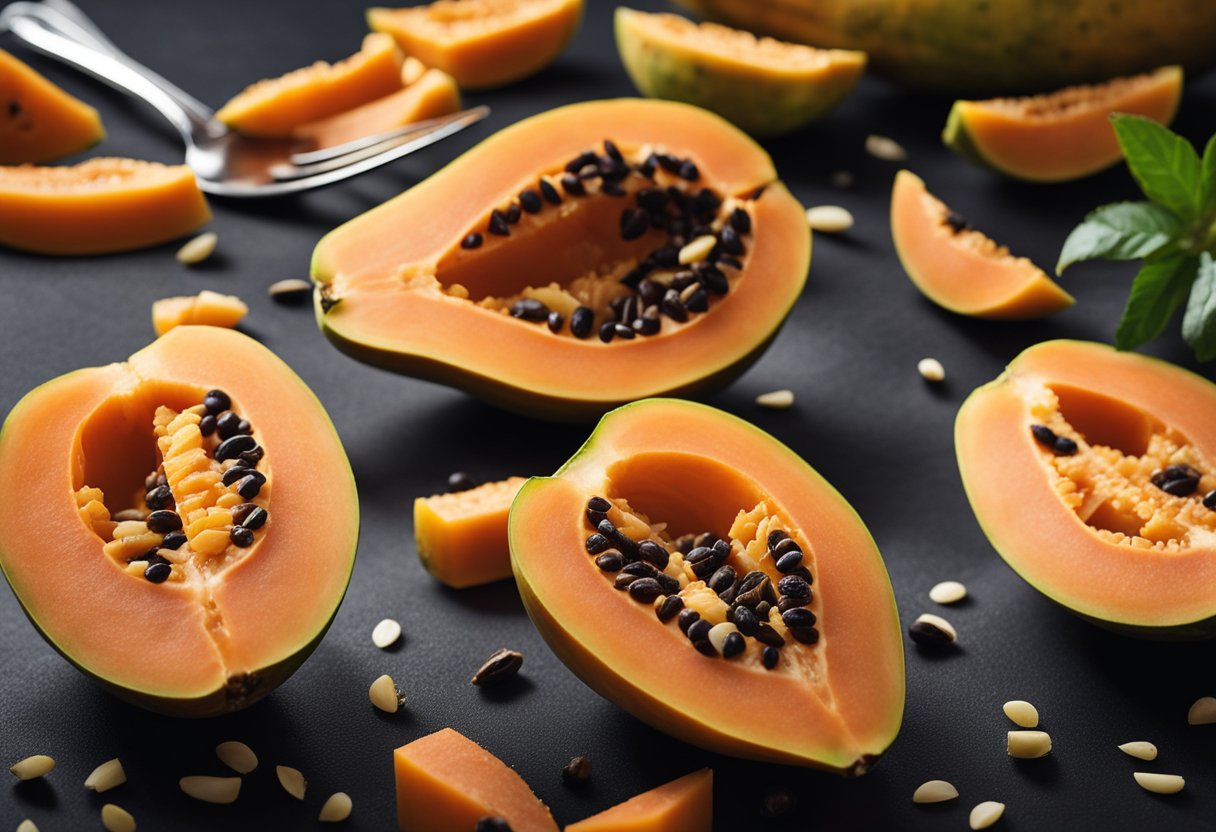
To enjoy the full potential of the papaya, it is essential to know when the fruit is ripe.
Mexican papayas, for instance, will gradually turn from green to yellow when approaching ripeness, while the ripeness of Hawaiian papayas can be determined by their skin texture. Perfectly ripe papayas have soft flesh that is easy to scoop out with a spoon, making it simple to savor their delightful taste.
There are several ways to enjoy papayas, including slicing them open, scooping out the seeds, and enjoying the fruit raw, or incorporating them into both sweet and savory dishes.
Adding a squeeze of lime or lemon can enhance the papaya’s natural flavor while blending with yogurt or teaming up with a spicy chutney can offer a unique spin on the fruit’s versatile taste.
Related: How to Eat Pomegranate Seeds
Recognizing a ripe papaya
Color and texture
A key indicator of a ripe papaya is its color. As papayas ripen, their skin changes from green to a yellow or orange hue. A ripe papaya typically has an almost fully yellow or orange skin.
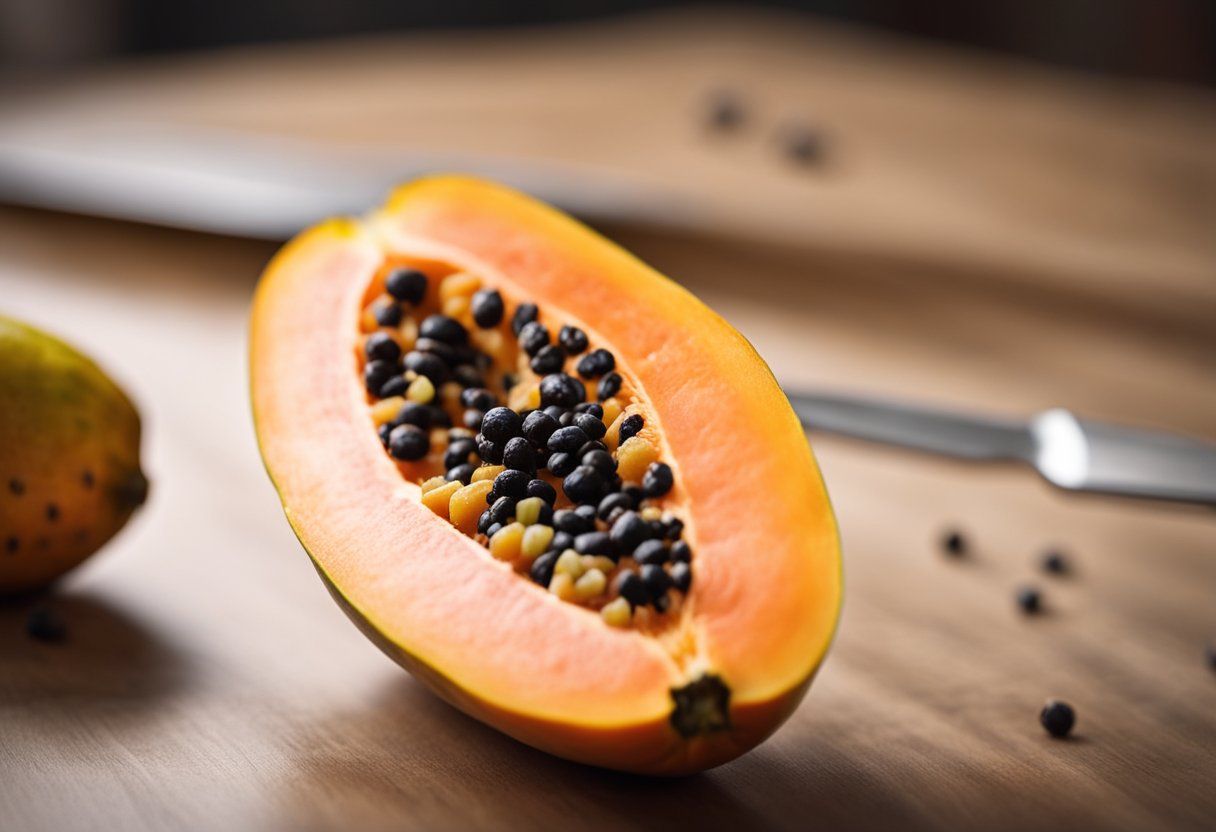
The texture of a ripe papaya is smooth, while an unripe papaya may have a harder texture. Remember that a green papaya is considered unripe, while a yellow or orange papaya is more likely to be ripe and ready to eat. An overly ripe papaya will have wrinkled or blemished skin.
Touch and smell
Another way to determine the ripeness of a papaya is by touching it and smelling it. A ripe papaya should be slightly soft when pressed, but not mushy.
Unripe papayas will be hard and not yield to pressure, while overripe papayas might be too soft or have visible soft spots on the skin. The smell of a ripe papaya should be mild and sweet, while an unripe papaya may not have any smell at all.
If you want to bring an unripe papaya to ripeness, you can let it sit at room temperature for a few days. Keep in mind that a ripe papaya has a more enhanced flavor and texture than an unripe one. So, it is crucial to recognize a ripe papaya to fully enjoy the delicious fruit.
Related: How to Eat Prickly Pear: A Simple and Safe Guide
Preparing papaya for consumption
Peeling and slicing
To prepare a papaya for eating, begin by using a vegetable peeler or a sharp knife to remove the skin. Ensure that you have a firm grip on the papaya while peeling it to avoid any accidents.
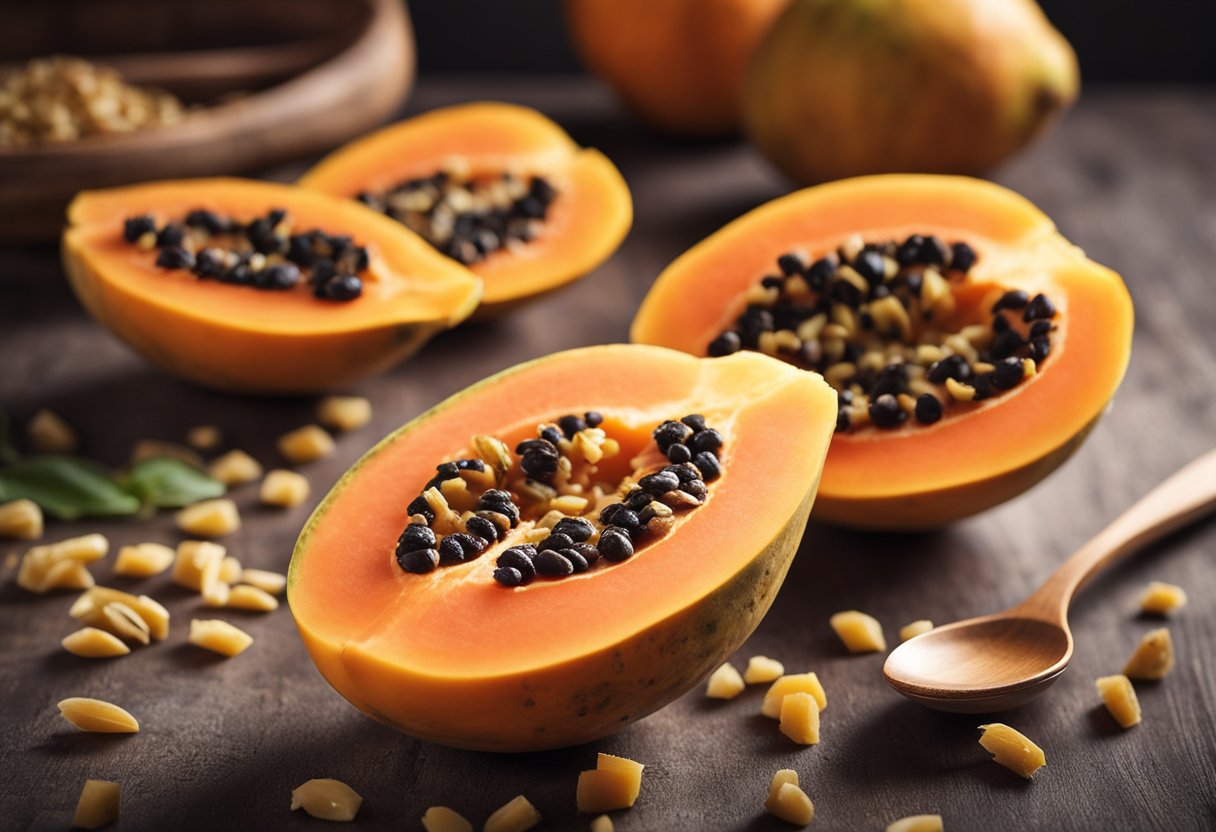
Once the skin is completely removed, it is time to slice the papaya into bite-sized pieces. Using a sharp knife, cut the fruit lengthwise into equal halves.
Removing seeds
After cutting the papaya in half, you will notice numerous small black seeds within its cavity. These seeds are edible but have a slightly bitter and peppery taste that may not appeal to everyone.
To remove them, simply use a spoon to scoop out the seeds from both halves. Make sure to discard the seeds or save them for later use if desired.
Rinsing the papaya
Before consuming the papaya, it is essential to give it a thorough rinse to remove any remaining dirt or debris. Place the papaya halves under cool running water and gently scrub the flesh using your hands.
Additionally, you may use a soft brush to clean areas that are hard to reach. After rinsing, pat the papaya dry using a clean cloth or paper towel.
Once the papaya has been peeled, sliced, seeded, and rinsed, it is ready to be enjoyed on its own or incorporated into various dishes for a delicious and nutritious tropical treat.
Related: How to Eat Guava: A Simple Guide for Enjoying This Tropical Fruit
Ways to eat papaya
Eating a raw papaya
One of the simplest ways to enjoy papaya is to eat it raw. To do this, first, make sure the papaya is ripe by looking for a golden-yellow color and a slightly soft texture.
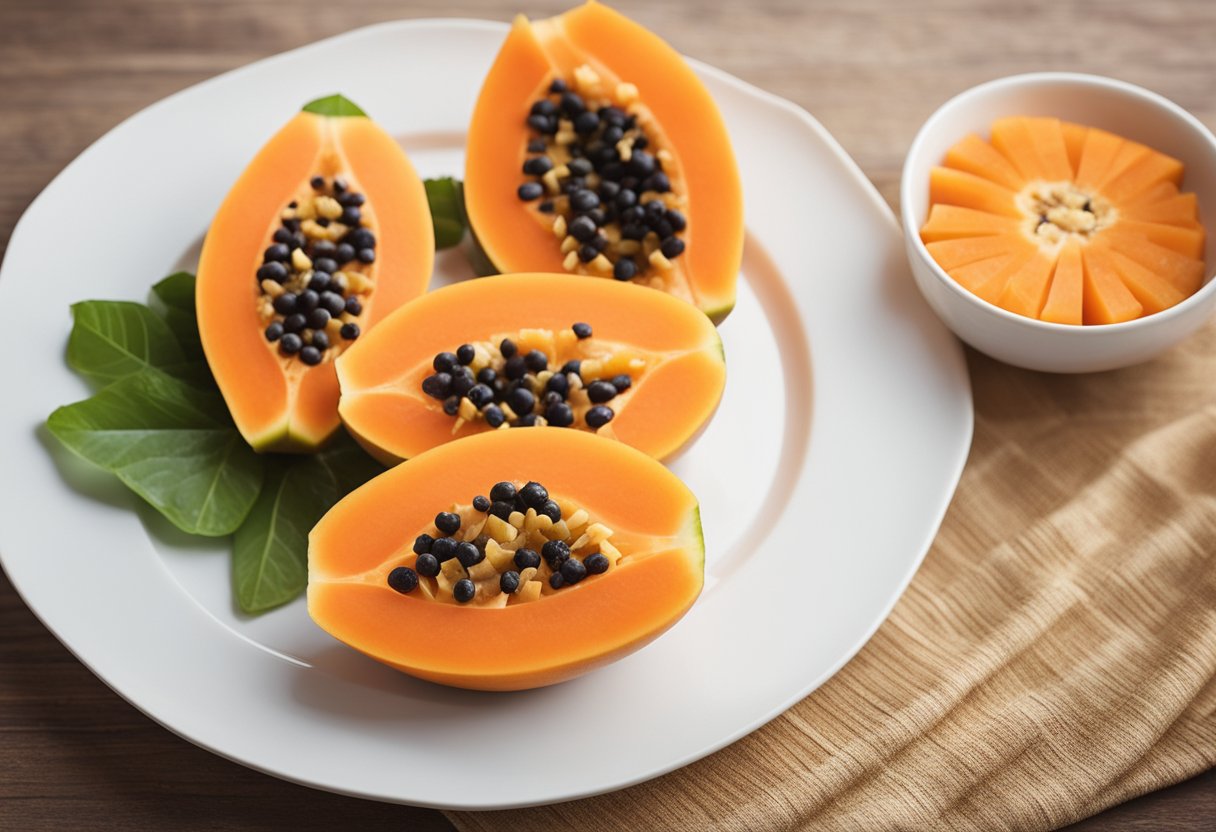
Next, wash the skin with soap and water, and then cut the fruit in half lengthwise. Scoop out the seeds using a spoon, and discard them1. Now, the fruit is ready to enjoy! If desired, add a splash of lime juice to enhance the flavor.
Papaya in salads
Papaya can be a delightful addition to various types of salads. Try adding chunks of ripe papaya to a mixed fruit salad2 for a tropical twist, or toss some papaya cubes with greens for a refreshing summery mix.
Smoothies with papaya
Incorporating papaya into smoothies is a great way to enjoy this nutritious fruit3. Combine papaya, yogurt, milk or a non-dairy alternative, and ice in a blender. Add other fruits, such as bananas or strawberries, and sweeteners like honey or agave syrup according to taste.
Papaya salsa
For a unique addition to your next meal, try making a papaya salsa4. Dice ripe papaya, tomatoes, onions, and jalapeño peppers, and mix them in a bowl.
Then, add lime juice, salt, pepper, and fresh cilantro. Let the mixture sit for 15-20 minutes to allow the flavors to meld, and then it’s ready to serve!
Desserts with papaya
Papaya can also be used in a variety of desserts5. For example, create a simple papaya sorbet by blending ripe papaya with sugar syrup and freezing it. Additionally, papaya can be baked in crumbles, bread, or even as a topping for cheesecake.
Adding flavor to papaya
Using lime or lemon
One way to enhance the flavor of papaya is by adding a splash of citrus. Drizzling lime or lemon juice on top of the papaya can provide a contrasting tangy taste, which complements the fruit’s natural sweetness.
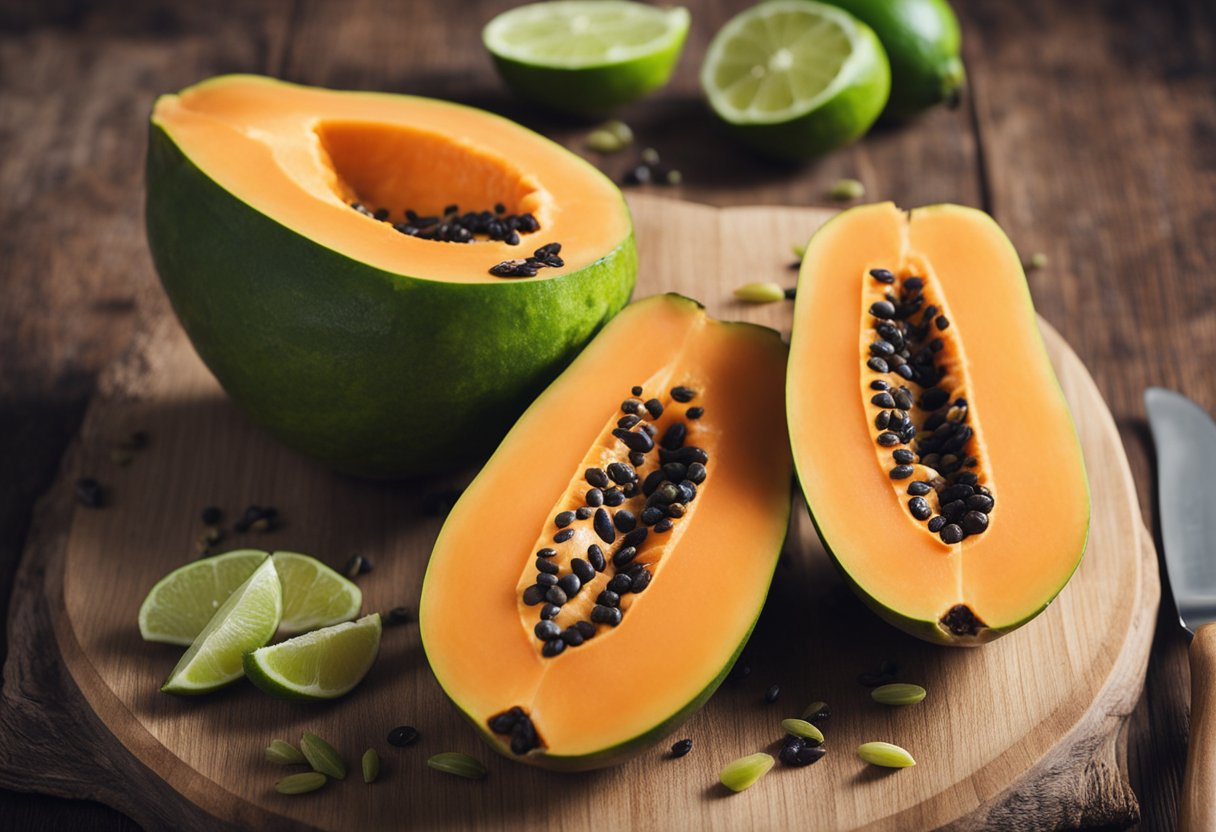
Simply cut the papaya into halves or cubes, and squeeze a fresh lime or lemon over it. This combination not only adds a delicious zest but also makes the papaya more appetizing.
Adding sugar or honey
If you prefer a sweeter taste, you can sprinkle some sugar or drizzle honey on your papaya. This addition can enhance the natural sweetness of the fruit, making it even more enjoyable.
To do this, you can either scoop out the papaya flesh with a spoon or slice it into pieces before adding sugar or honey to suit your taste buds.
Seasoning with other tropical fruits
Papaya can be combined with other tropical fruits to create a vibrant and flavorful fruit salad. Mixing papaya with fruits like mango, pineapple, or kiwi can provide a delectable medley of flavors, textures, and colors.
To prepare a tropical fruit salad, simply chop your chosen fruits into bite-sized pieces, and toss them together in a large bowl. The combination of these fruits will not only create a visually appealing dish but also a delicious and healthy snack.
When adding flavor to papaya, remember to keep it simple and focus on ingredients that complement its natural sweetness. Whether you prefer citrus, sweeteners, or other tropical fruits, incorporating these flavors can enhance your papaya-eating experience.
Nutritional value of papaya
Vitamins and minerals
Papayas are an excellent source of several essential vitamins and minerals. They are rich in vitamin C, which plays a vital role in boosting the immune system and promoting skin health.
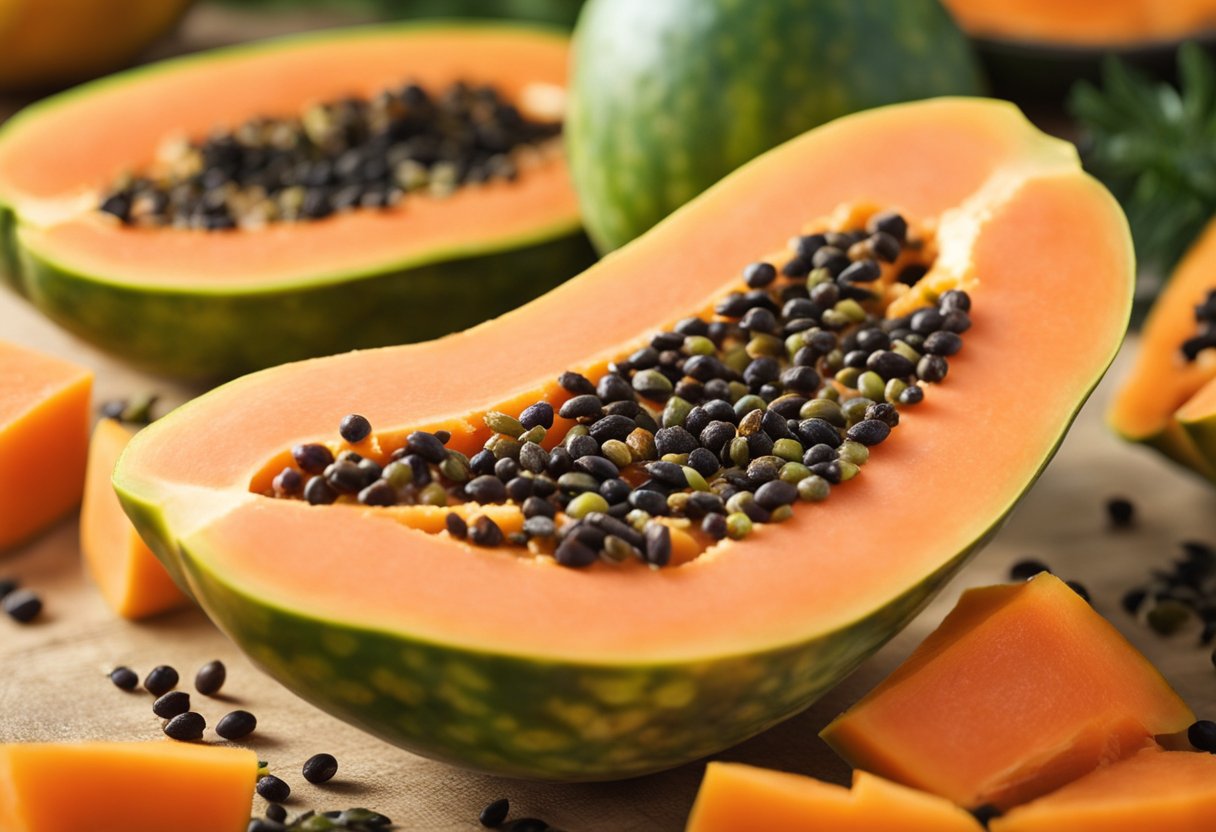
Papayas also contain vitamin A, which is important for maintaining healthy vision and skin. Additionally, these fruits are a good source of folate, calcium, iron, and magnesium, and provide moderate amounts of other nutrients, like potassium.
Caloric and fiber content
A single serving of papaya, or around 145 grams, contains just 62 calories, making it a low-calorie food that is suitable for those looking to maintain their weight or lose weight. Furthermore, papaya is a good source of fiber, with 2.5 grams in a 1-cup serving. This fiber content aids in digestion and helps maintain a healthy digestive system.
Health benefits of eating papaya
Eating papaya offers numerous health benefits, thanks to its rich nutritional content. Some of these benefits include:
- Antioxidants: Papaya contains antioxidants such as vitamin C and vitamin A, which help fight free radicals in the body, potentially reducing the risk of chronic diseases and supporting overall health.
- Papain enzyme: Papaya is known for its unique papain enzyme, which aids in digestion by breaking down proteins into smaller peptides or individual amino acids. This enzyme can also help reduce inflammation and improve overall digestive health.
- Potassium and heart health: Papaya is a good source of potassium, which supports heart health by regulating blood pressure and heart rhythm. Potassium has also been linked to a reduced risk of stroke and heart disease.
- Fiber and digestive health: As mentioned earlier, papaya contains a significant amount of fiber, promoting a healthy digestive system and preventing constipation.
In summary, consuming papaya offers an array of essential vitamins, minerals, and other nutrients, which contribute to its numerous health benefits. Its low caloric content and high fiber content make it a nutritious and delicious choice for those looking to maintain or improve their overall health.
Health benefits of papaya
Papaya for digestive health
Papaya is well-known for its positive impact on digestive health. One of its key components is an enzyme called papain, which helps break down proteins, making them easier to digest.
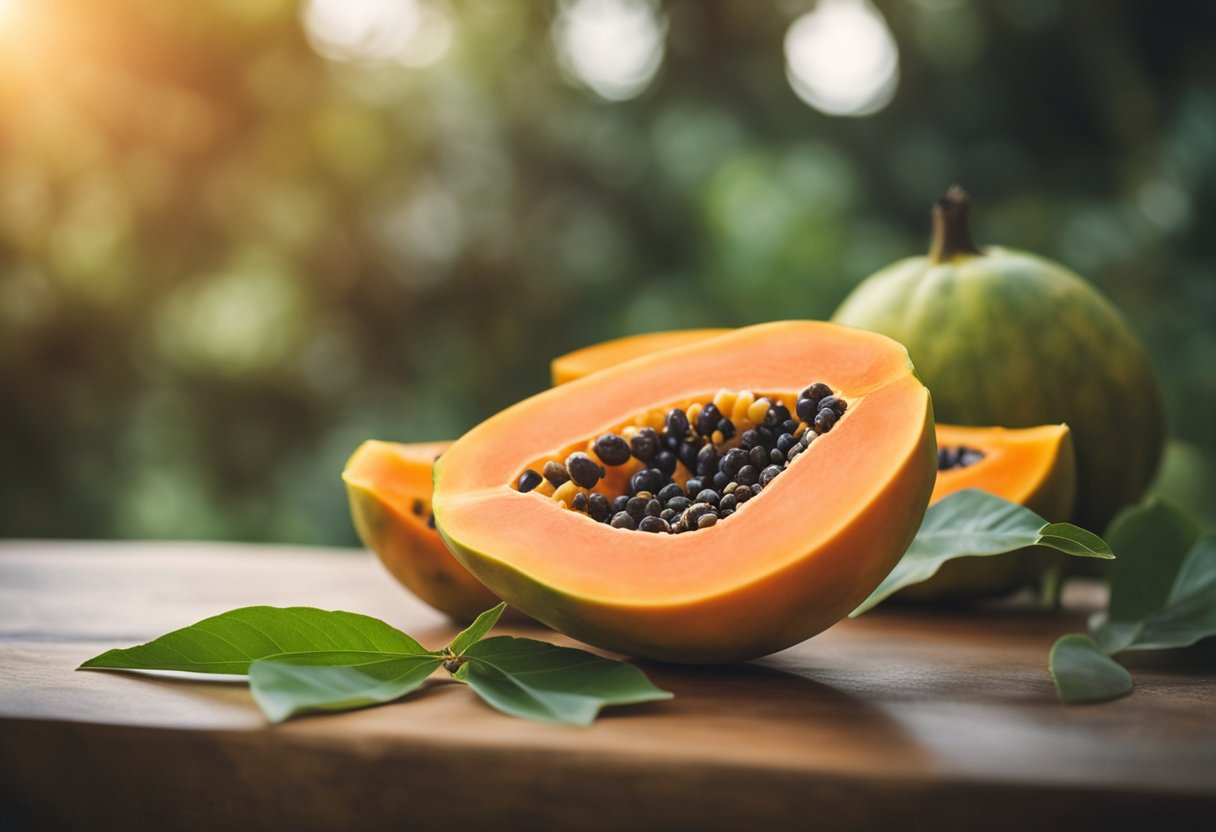
Furthermore, papaya’s high fiber content can alleviate constipation, promoting regular bowel movements.
Benefits for heart health
Regular consumption of papaya may lead to improved heart health. The fruit contains essential nutrients like potassium, which helps maintain healthy blood pressure levels.
Additionally, its high levels of antioxidants, such as lycopene and beta-carotene, help reduce oxidative stress and inflammation, two major contributors to heart disease.
Papaya for eye health
Papaya is packed with powerful antioxidants like beta-carotene and vitamin C, which promote eye health and protect against age-related macular degeneration. Furthermore, its high concentration of lutein and zeaxanthin may reduce the risk of cataracts and other eye complications associated with aging.
Potential cancer prevention
Some studies suggest that papaya’s rich antioxidant content and unique phytonutrients may help in cancer prevention. Lycopene, a powerful antioxidant found in papaya, has been shown to reduce the risk of certain types of cancer, such as prostate, lung, and stomach cancer.
Additionally, its anti-inflammatory properties can inhibit the growth of cancerous cells and help maintain overall cellular health.
Storing and preserving papaya
Keeping papaya at room temperature
When storing unripe papayas, the ideal method is to leave them at room temperature. This allows them to ripen naturally and develop their full flavor.
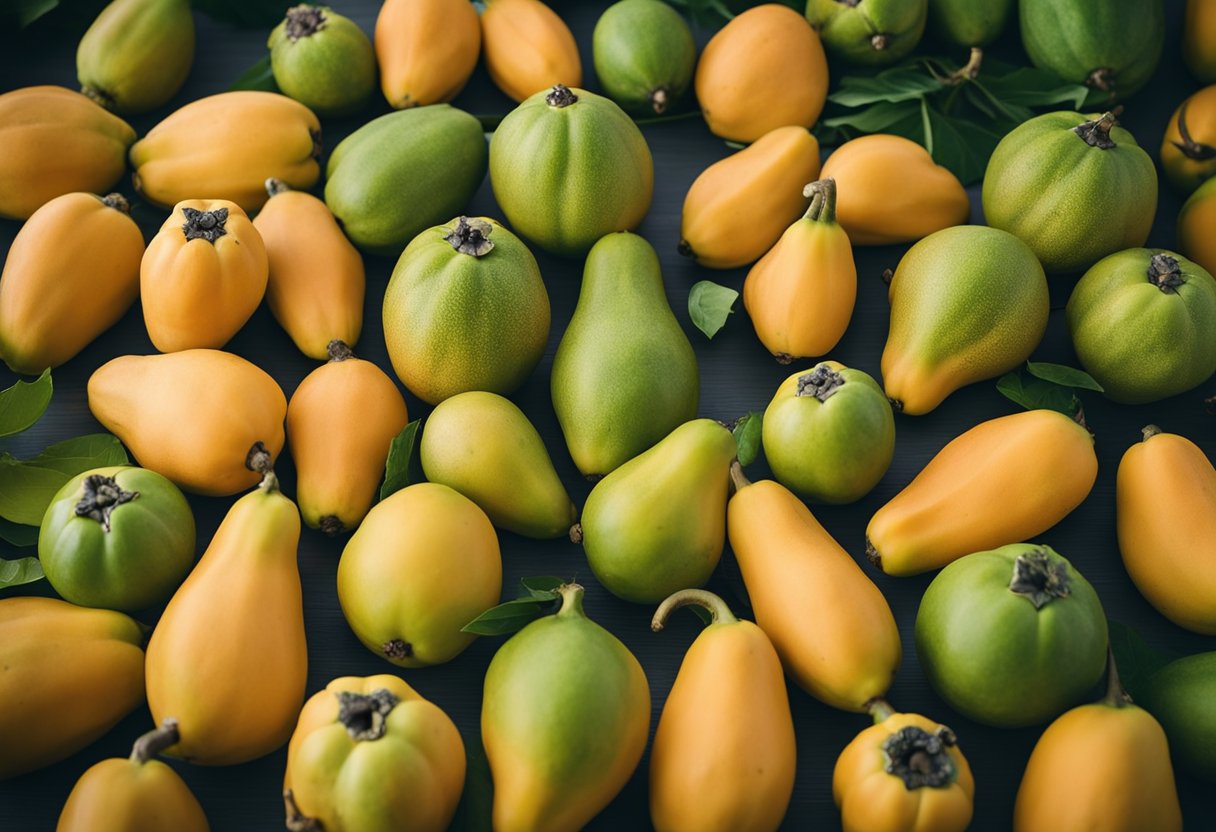
Keep in mind that exposure to ethylene gas sources, such as bananas or apples, can accelerate the ripening process. To store papayas at room temperature, place them in a cool, dry area away from direct sunlight and ethylene-producing fruit.
Refrigerating papaya
Once your papayas become ripe, it’s time to transfer them to the refrigerator. Cold temperatures slow down the ripening process and help preserve the fruit for a longer time.
According to Upgraded Home, ripe, unpeeled papayas can be stored in the refrigerator for up to three weeks. Ensure that you keep them in a fruit drawer or a low-humidity section of the fridge to maintain freshness.
If your papaya is already cut, wrap it tightly with plastic wrap or store it in an airtight container before placing it in the fridge. This method helps protect the fruit from developing off-flavors or getting too moist. Cut papaya should be consumed within a week to maintain its best taste and texture.
Freezing papaya
Freezing is an excellent option for long-term storage, especially if you have an abundance of ripe papayas or need to preserve cut fruit. To freeze papayas, remove the seeds and peel from the fruit, then cut it into small chunks or slices.
Arrange the pieces on a baking sheet or tray lined with parchment paper, ensuring they are not touching each other to prevent them from freezing together. Freeze the papaya pieces until solid, and then transfer them to airtight freezer bags or containers.
According to Upgraded Home, frozen papaya can be stored for up to a year without significant losses in taste or texture, making it a convenient option for enjoying this tropical fruit all year long. When you’re ready to eat the frozen papaya, simply thaw it in the refrigerator or at room temperature before incorporating it into your recipes or enjoying it on its own.
Global usage and significance of papaya
Papaya is a tropical fruit that has been cultivated and enjoyed around the world for centuries. It is known for its sweet taste, vibrant orange color, and numerous health benefits.
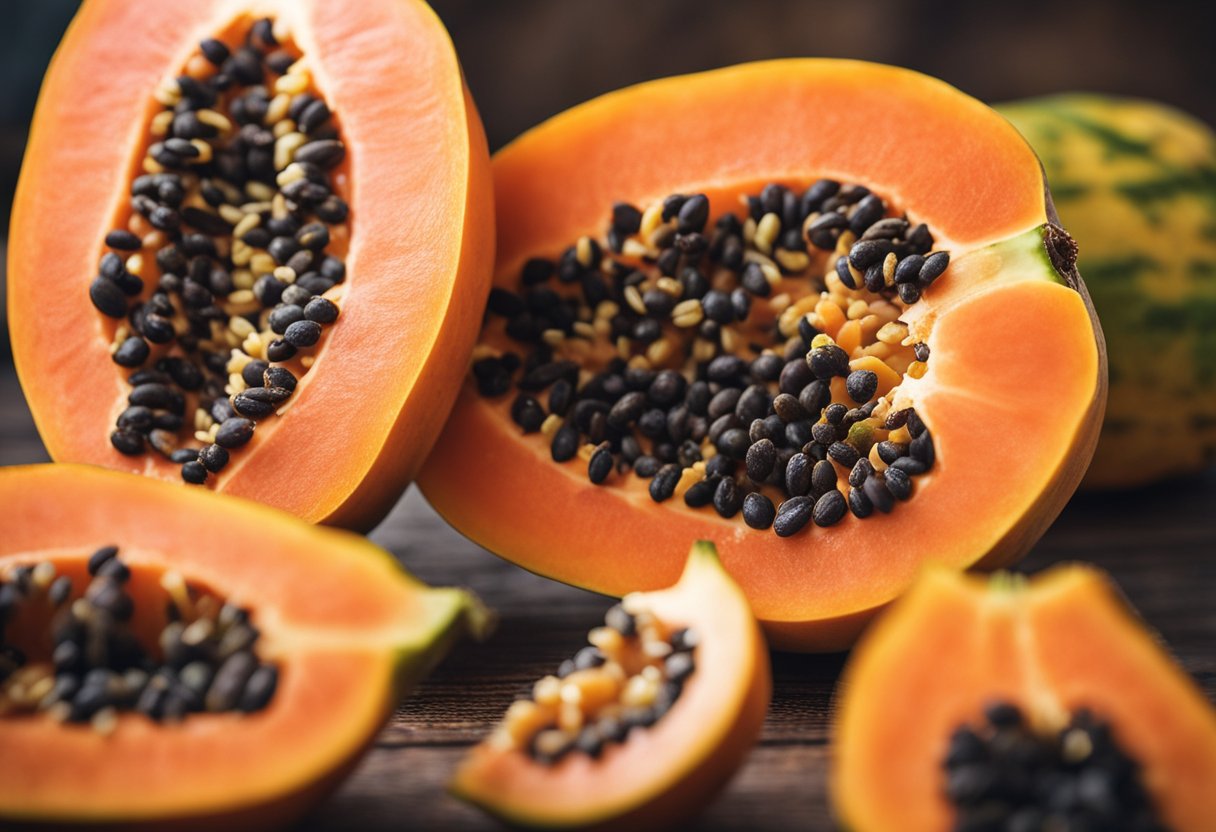
In different regions of the world, papaya has its own unique significance and is utilized in various ways. This section will discuss the usage and importance of papaya in Mexico, Hawaii, South America, and Asia.
Papaya in Mexico
Mexico, where the papaya plant was first domesticated, is known for its diverse uses of the fruit. In Mexico, papaya is an essential part of the local cuisine and is often used as a base for many traditional dishes, such as salads, salsas, and desserts.
The fruit is also consumed fresh, typically with a squeeze of lime juice and a sprinkle of chili powder, making it a popular summertime snack.
Hawaiian varieties of papaya
Hawaii, while not the native land of papaya, has become synonymous with the fruit due to its cultivation of distinct varieties. The most well-known Hawaiian papaya is the Solo papaya, which is smaller and sweeter than other types.
These papayas are typically consumed fresh or in fruit salads, smoothies, and desserts. The Hawaiian agricultural industry has even developed genetically modified papaya varieties to protect them from the papaya ringspot virus.
Papaya in South America
In South America, countries like Brazil and Colombia are major papaya producers. Here, the fruit is revered for its medicinal properties, such as aiding digestion and reducing inflammation.
It is also commonly used in desserts like the Brazilian mousse de mamao, made with ripe papaya, cream, and sugar. Furthermore, in countries like Peru, the seeds of the papaya are dried and ground to create a unique seasoning known as papaya pepper.
Papaya in Asia
Papaya is an essential component of the culinary culture in various Asian countries like the Philippines, Thailand, and Indonesia. In the Philippines, green, unripe papaya is frequently used as a vegetable in dishes like tinola, a chicken soup with papaya and chili leaves.
Meanwhile, in Thailand, green papaya is the central ingredient in the beloved national dish som tam, a spicy salad with a mixture of flavors such as sweet, sour, and salty. In Indonesia, ripe papaya is often incorporated into fruit salads or made into kolak, a sweet dessert soup.
In conclusion, papaya holds a prominent place in the global culinary landscape and has cultural significance in various regions. Its versatility, taste, and health benefits have made the fruit a cherished staple across Mexico, Hawaii, South America, and Asia.
Papaya recipes and incorporation into diverse cuisines
Papaya, a tropical fruit, offers a wealth of health benefits and can be incorporated into various recipes and cuisines.
Utilizing papaya in meat recipes
Papaya contains papain, a natural enzyme that helps tenderize meat. It is often used in marinades to add a touch of sweetness and to help break down tough fibers in the meat.
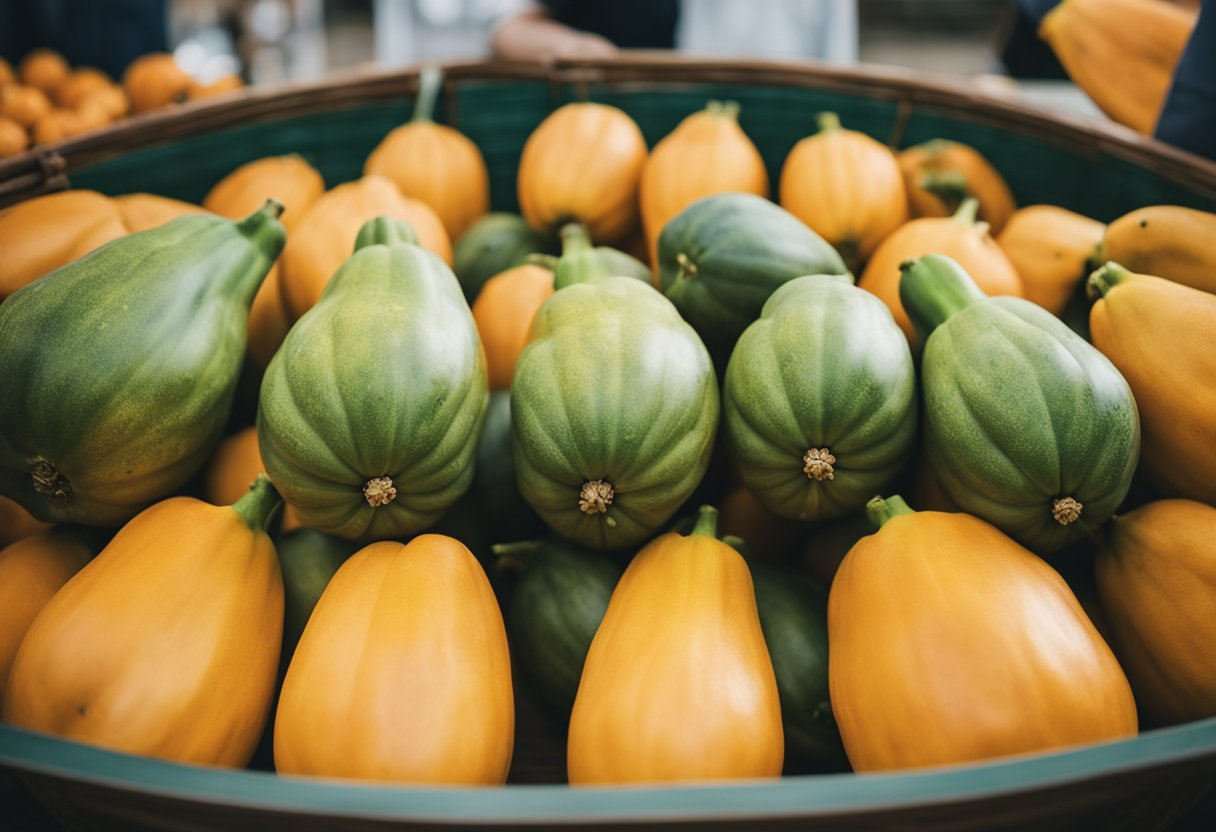
One popular method is combining papaya chunks with ingredients like coconut, pineapple, and tomatoes to create a marinade for meats such as chicken or pork. In tropical regions, papaya is commonly used in traditional dishes, where the fruit complements the bold and spicy flavors.
Adding papaya to desserts
Papaya is an excellent addition to desserts, not only for its bright color but also for its natural sweetness. One simple dessert idea is baked papaya, which consists of halved and seeded papaya filled with a mixture of cinnamon, honey, and chopped nuts.
Preheat your oven to 350°F, place the filled papaya halves on a baking sheet, and bake until tender. Another option is to create a tropical fruit salad by combining papaya, pineapple, and coconut.
Refreshing papaya beverages
Papaya can be transformed into a delicious and refreshing beverage by blending it with other tropical fruits or juices.
To create a papaya smoothie, cut the papaya into chunks and blend it with your choice of fruit, such as pineapples, mangoes, or bananas, and a splash of coconut milk. For added flavor and health benefits, consider including papaya seeds in the blend, as they are renowned for their nutritional properties.
In conclusion, incorporating papaya into various recipes adds flavors, color, and health benefits to any dish, from tenderizing meats to creating delightful desserts and refreshing beverages.
